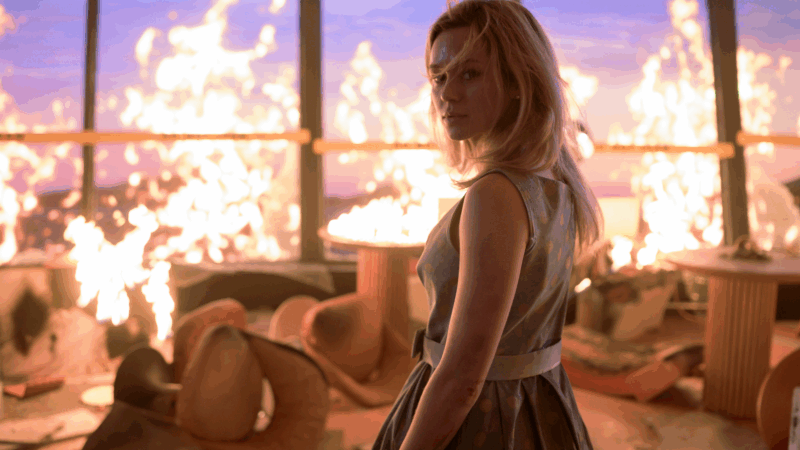‘Gore is back, baby!’ Directors of ‘Final Destination’ are pushing bloody boundaries
Reviving a franchise that hasn’t released a movie in over a decade is a daunting task, especially for a series as well-loved as Final Destination.
Horror fans’ anticipation for the series’ newest, sixth film has been brewing ever since franchise creator Jeffrey Reddick confirmed it was in the works back in 2020. And now, it’s finally here — 25 years after the premiere of the very first movie.
Co-directors Zach Lipovsky and Adam Stein took on the challenge of reviving the series with Final Destination Bloodlines and spoke with NPR about the secret sauce behind making one of these deadly movies.
For those who aren’t familiar, every Final Destination film — including this one — follows a formula: the central character experiences a premonition of a tragedy that’s about to strike, like say, a plane crash. Then they snap out of it, realize there’s still time and manage to save (some of) those in danger.
The catch is: that wasn’t part of Death’s plan. And since this plan has been disrupted, Death spends the rest of the film picking off each survivor, one-by-one, by any means necessary. In this latest installment, the premonition that acts as the sixth film’s catalyst comes to the main character in a recurring nightmare. Turns out, her grandmother managed to hold off Death for decades. So the title, Final Destination Bloodlines, nods to the fact that her entire family is in danger, because they were never meant to exist.

And it’s worth noting: Death isn’t part of the cast — it’s an omnipresent entity.
“There is no slasher in this movie, there is no villain, there is no person in a mask or ghosts in the shadows,” Stein told NPR.
For the directors, building suspense in these scenes is part of the fun.
“The opportunity to kind of create death sequences as filmmakers is really a filmmaker’s dream come true,” Stein said. “The death that comes for you in Final Destination is really death by filmmaking.”
Take, for example, the most notorious scene from Final Destination 2, which features a log truck barreling down a highway. Before anything even goes wrong, dread sets in. That’s because of alternating closeups of massive logs coming unchained with shots of clueless drivers right behind it. You can probably guess what happens next.
Final Destination is famous for the creative and gruesome ways it kills off its characters. The terror comes partly from how normal a lot of these deathly circumstances seem, and how characters end up dying in bizarre series of accidents like particularly horrible Rube Goldberg machines. These scenes stick with viewers because they tug on anxieties that might already exist.
“One of the fundamental building blocks of a Final Destination movie is relatable fears… everything that we build [scenes] around have to be elements that people run into in their daily lives,” Lipovsky told NPR. “That may be: when you go into a tattoo parlor, or you go into a tanning bed, or you go to get Lasik eye surgery… It gives you an icky feeling, but you do it anyway.”
Lipovsky and Stein are big fans of the franchise themselves, that’s part of the reason they took on the project — and it shows. The newest film is filled with Easter eggs referencing moments from past installments.
“We even are just finding some [references] ourselves, because we really encouraged the crew to put as many little small details as they could into the film without even telling us,” Stein said.

Despite Final Destination Bloodlines being bigger and bloodier than ever, getting the tone right was tricky for its directors — a film about family members dying one-by-one needs to be scary and suspenseful, but can’t be depressing. Part of the solution to balancing these themes was comic relief.
“We wanted the movie to be a movie that you kind of have to watch through your fingers because you’re in such suspense, but you also have a huge smile on your face while you’re watching,” he said. “That balance of you’re cringing, but you’re also laughing.”
Final Destination is known for its over-the-top gore, sometimes to the point of silliness, and this film doesn’t hold back. The directors told NPR they recorded extra bloody scenes just to make sure they had enough, and turns out, they needed it.
“When we showed it to audiences, the studio and [everyone] involved were shocked at how much more gore the audience was asking for compared to 15 years ago. And we went and added even more in,” Lipovsky said. “We really wanted it to be something that is surprising and kind of this joyful explosion of blood.”
Lipovsky is right, gore seems to be more common and more extreme in cinema lately — and not even just in the horror realm. Part of it might have to do with television moving towards streaming, so the restrictions on graphic content for network television don’t apply anymore.
Bloody, graphic movies are a trend like anything else — as Liposky put it: “gore is back, baby!”
“Everyone’s kind of been pushing the boundary together. So you have shows like Game of Thrones or Squid Game that teenagers are watching that are very graphic and bloody,” Stein said. “Tastes have kind of acclimated to it, so if you go to the theater to see Final Destination, you want to go all the way and really, ya know, see stuff happen.”
Light from satellites will ruin majority of some space telescope images, study says
Astronomers have long been concerned about reflections from satellites showing up in images taken by telescopes and other scientific instruments.
Defense Department is reviewing boat strike video for possible release, Hegseth says
In a speech on Saturday, Defense Secretary Pete Hegseth defended the strikes, saying: "President Trump can and will take decisive military action as he sees fit to defend our nation's interests."
Bama, Miami in, Notre Dame out and Indiana No. 1 in College Football Playoff rankings
Nobody paying attention for the past 24 months would be surprised to see Indiana – yes, Indiana – leading the way into this year's College Football Playoff.
McLaren’s Lando Norris wins first F1 title at season-ending Abu Dhabi Grand Prix
Red Bull driver and defending champion Max Verstappen won the race with Norris placing third, which allowed Norris to finish two points ahead of Verstappen in the season-long standings.
A ban on feeding pigeons ruffles lots of feathers in Mumbai
The pigeon population has exploded — a result of people feeding the birds. For some it's a holy duty and a way to connect to nature. Critics point to health risks tied to exposure to pigeon droppings.
UN humanitarian chief: world needs to ‘wake up’ and help stop violence in Sudan
The UN's top humanitarian and emergency relief official has told NPR that the lack of attention from world leaders to the war in Sudan is the "billion dollar question".








